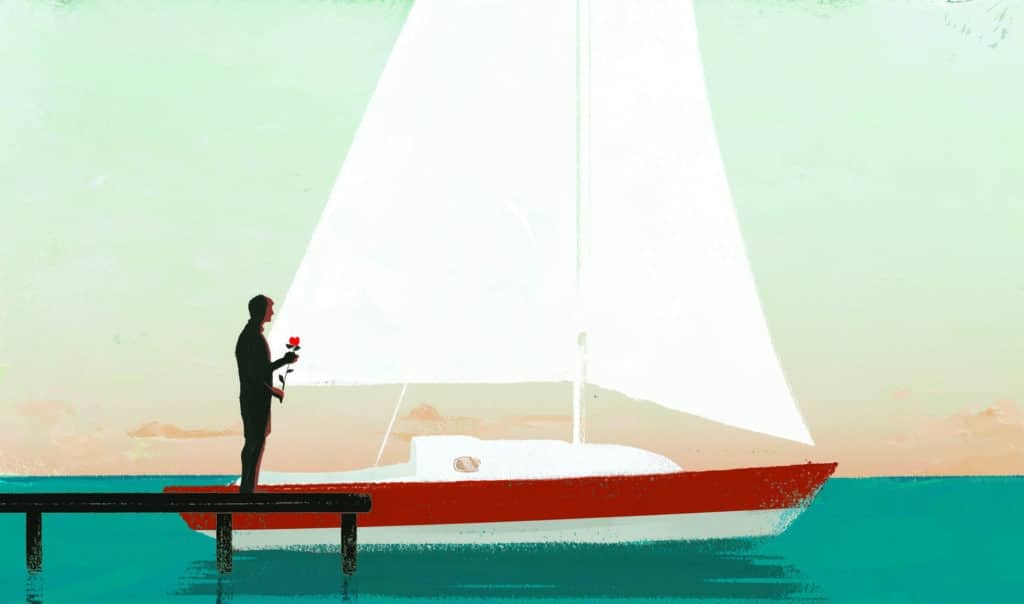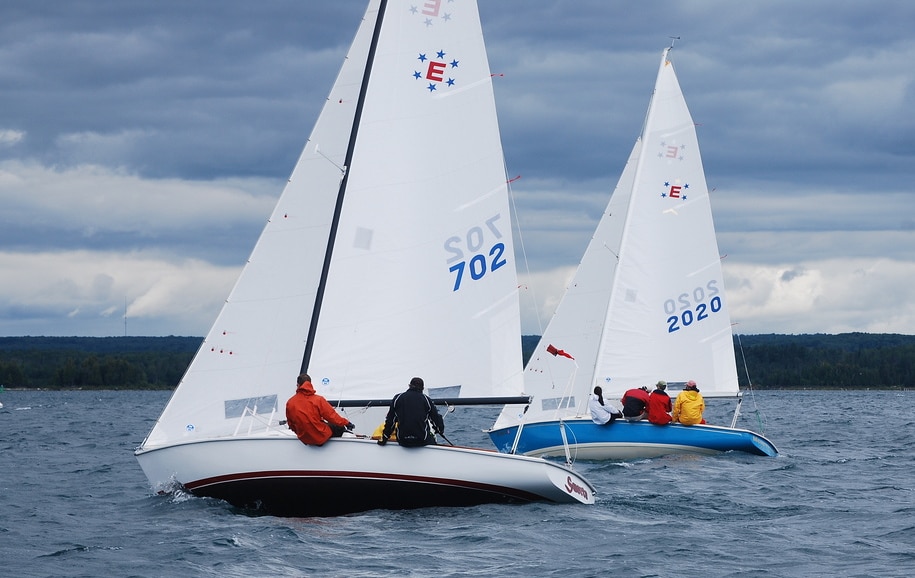
On a warm spring day in 2006, Houston YC’s harbor was alive with sailboats, large and small, coming and going from their slips. Signal flags fluttered from the club’s yardarm, and masthead vanes pointed into the 10-knot afternoon southeasterly sweeping across Galveston Bay. This was not my first visit to Pier 10, home of the club’s Ensign fleet. Many times before I’d walked the dock to admire the Ensigns, wondering which one might be the best fit for me, and on this occasion a blue hull caught my eye. Its skipper deftly headed her into the breeze and coasted into a slip. As I watched, I could imagine myself at its helm.
The elegant lines of the Carl Alberg design, its stout fiberglass hull, bright work coaming boards and 8-foot cockpit seemed a perfect answer to the question looming over me: What would be the best class for an older sailor like me after years of fast, wet racing machines?
I was searching for something to race and sit comfortably inboard with a backrest yet still enjoy the thrill of one-design racing. For my wife, Paula, and me, the Ensign stood out as our next perfect sailboat. I could take part in a competitive fleet one day or set out on a comfortable day sail with friends and family.
Once I expressed interest in the Ensign, it wasn’t long before I was introduced to Dean and Kay Snider, who hosted us for a sunset sail on Little Oil. We anchored in Woozy Bay for cold drinks and a picnic dinner. Little did I know, they were romancing me into their fleet. After that inaugural cruise, I crewed on Little Oil many times and took careful notes on rigging, sail trimming and spinnaker evolutions. In the fall, I began to take inventory of available Ensigns at the club, ideally one that didn’t require major rehabilitation. In February 2007, I finally found No. 1029, a 1966 Pearson-built hull, in Dunedin, Florida. I trailered it home to Houston and christened her The Other Woman, with Paula’s blessing, of course. After seven years of club racing at the Houston YC, I was ready to take her on the road to compete with East Coast Ensign sailors. Our first trip was to St. Petersburg, Florida, for Midwinters. There were 10 Ensigns on the starting line for the three-day regatta, and having never raced with more than five or six Ensigns at once, it was an entirely new experience for The Other Woman and its crew. We posted three fourths in the seven-race series and finished fifth overall.
We were pleased with our midfleet standing in our first major regatta, and the experience only served to wet our appetite for national-level racing. Soon after, plans hatched for the long haul to Niantic, Connecticut, for the 2015 Ensign National Championship. The one thing we learned from our trek to Florida was that successful road trips with a heavy sailboat in tow is all about one thing: the trailer.

Three hours into our haul to Connecticut, we felt a jolt, heard a bang, and in the rearview mirror, I could see trailer tire parts flying across Interstate 10. We knew immediately we had a big problem. With no paved shoulder, changing the tire was a challenge. We had to break the last stubborn lug nut to remove the damaged tire and put on the spare. We crept into Crowley and found a tire store. After a three-hour delay and the purchase of two shiny new trailer tires, we were back on I-10. “Niantic or bust,” was our mantra.
Following our GPS navigation system, we entered Connecticut on the Merritt Parkway, passing under a steel-frame bridge with a 9’6″ clearance. I had driven under it before, but never with a sailboat on a trailer. Not actually knowing the height of our haul with the mast tied atop, I shifted to the center lane as we drove under the many historic stone-bridge crossings.
At one point, while crawling in stop-and-go rush-hour traffic, an ambulance driver ahead of us stepped out of his vehicle and walked up to my driver side door, admonish. “You should be on I-95,” he scolded. “There are big fines driving on the Merritt Parkway with a boat trailer.”
I begged his pardon, telling him we were from Texas and didn’t know any better. Besides, we were bound for the next exit, New Canaan. The next morning, I measured the mast height: 9’4″ above the pavement, and thanked our lucky Texas stars. Forty Ensigns competed in eight races, and our best finishes were an eight and a 12, so we finished 20th. After the last race, a fellow Ensign sailor told me that with our placing, we’d won the Doug Wood Mid-Fleet Trophy. What a surprise, in our first Ensign National Championship regatta, The Other Woman had hardware to haul back south. Our travels continued to the Ensign Midwinters on Lake Murray, South Carolina, where we chalked up another midfleet finish.
Encouraged by three midfleet finishes, we have plans for Cedarville, Michigan, in August to compete in the Ensign Nationals. It’s another long haul, but one guided by the wisdom of our christening prayer for The Other Woman a decade ago: “We pray for safe sailing, and spare us large expenses along the way.”
While we’ve returned home safely from every race and every escapade, she does demand constant upkeep and tender care to keep her in Bristol fashion ready for the next sailing adventure. Certain ladies, however, are worth every extra penny.









